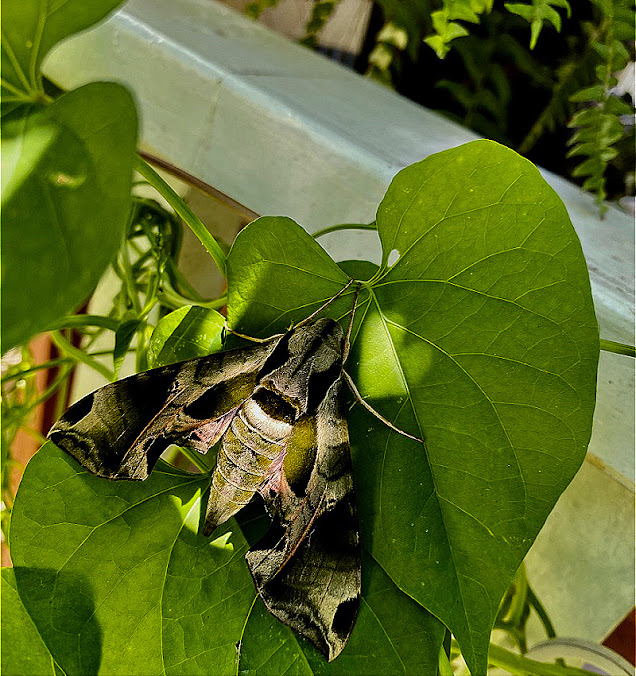How unexpected and exciting!
Yesterday when watering I discovered a rarely seen garden visitor of
mammoth proportions for its species. A glorious hawk moth - sometimes
called the 'hummingbird moth' because it's about the same size - sleeping
under the shade of the morning glory leaves which I'm training
up the porch rails. Note how it clings with its outstretched legs.
It doesn't bite or sting, but apparently when it flies it buzzes.
Its wingspan would be about 4 inches - this is no tiny moth such as
the devils who search through our closets for our cashmere sweaters!
What a beauty!
Pandorus Sphinx Moth : Eumorpha pandorus
Hawk moths are fast fliers and nocturnal. The Pandorus Sphinx Moth
sports a camouflage pattern of army green color with earthy undertones.
The rotund abdomen has a dark green band followed by a bright white band
just after the head and thorax area. The rest of the abdomen is a lighter
shade of muted green. The head and thorax are mostly cream colored with
dark green stripe running down the middle. Thorax sides are dark green.
Wings are narrow and aerodynamic, unlike the wide feathery wings seen
in many other moths.
Nature went all out when painting this beauty.
The Pandorus Sphinx Moth drinks nectar from various flowers
so it is most likely to be found in gardens, vineyards, near rivers, or
in meadows. It can also be found near forest edges or blending in with
the foliage inside woodlands. This species is attracted to lights at night
and is active from spring through fall. It enjoys warmer climates and is
best viewed at dusk or dawn, when it is most active.
This is what they love - moonflowers and morning glories.
I have both growing up the porch with a few morning glory blooms
already, but the moonflowers will come later - this photo above was
from another summer.
The moth remained all day and I was excited to share it with granddaughter
Jasmin who came to supper - we grilled out and dined in the gazebo as it
was a perfect evening.
Later, after dark, when saying goodbye to Jasmin, and watching that
awesome rising of the last super moon of this year, the 'Strawberry Moon',
I noticed the moth had left on its search for supper. . . . . and it's not here
this morning.
Sadly, their lifespan is a brief 30 days or so. I'm now searching
for their fat green caterpillars - maybe they'll be around later when
the moonflowers bloom!
Any surprise visitors to your garden lately?
Have a fabulous weekend wherever you are.








.png)




























































































We had one once here some years ago, but none since. In our garden in France they were quite common and we used to watch them going from flower to flower, hunting for nectar.
ReplyDeleteGlorious - we in the UK call those Oleander Hawk Moths - they are very rare indeed here. I am fascinated by moths - sad to say I have two victorian cabinets full of specimens - including many hawkmoths!
ReplyDeleteWe have hummingbird moths here in IL, but they look different from your hawk moth. The ones here look like giant bumblebees with hummingbird wings! They love the bee balm in my butterfly garden.
ReplyDeleteOh, how exciting!! All entomological fauna in this neck of the woods is rather larger and noisier than life but I've never seen this giant beauty before. Brilliant photos, Mary!
ReplyDeleteDearest Mary,
ReplyDeleteSpectacular photos of your Pandora Sphinx Moth!
Glad that your Granddaughter Jasmin got to view it as well.
It is not to be confused with the Hummingbird Hawk Moth though, that is so different.
We only captured once the Hummingbird Hawk Moth: https://mariettesbacktobasics.blogspot.com/2011/03/our-japanese-somei-yoshino-cherry-in.html
Hugs,
Mariette
What a beauty! We have a Hummingbird Hawk Moth here in the UK, though it's smaller - just two inches across - though it is pink and lime-green. I haven't seen one here for some years.
ReplyDeleteThat was indeed a beautiful and special visitor at your garden! Thank you for sharing it with us.
ReplyDeleteLove morning glory. Never knew about the 30 days span.
ReplyDeleteThat hawk moth is gorgeous. What a treat to have him visit your garden.
ReplyDeleteWishing we could have a bit of your rain.
What a magnificent moth! I've never seen one before. No exciting visitors to our garden recently.
ReplyDelete